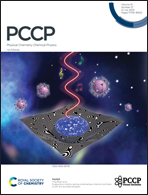Effect of oxidation on POPC lipid bilayers: anionic carboxyl group plays a major role†
Abstract
Phospholipids with unsaturated acyl chains are major targets of reactive oxygen species leading to formation of oxidized lipids. Oxidized phospholipids have a pronounced role in cell membrane damage. We investigated the effect of oxidation on physiological properties of phospholipid bilayers using atomistic molecular dynamics simulations. We studied phospholipid bilayer systems of 1-palmitoyl-2-oleoyl-sn-glycero-3-phosphocholine (POPC) and its two stable oxidized products, 1-palmitoyl-2-(9′-oxo-nonanoyl)-sn-glycero-3-phosphocholine (PoxnoPC) and 1-palmitoyl-2-azelaoyl-sn-glycero-3-phosphocholine (PazePC). Structural properties of the POPC lipid bilayer upon the addition of PoxnoPC or PazePC with concentration ranging from 10% to 30% were described. The key finding is that PazePC lipids bend their polar tails toward the bilayer-water interface whereas PoxnoPC lipids orient their tail toward the bilayer interior. The bilayer thickness decreases such that the thickness reduction in bilayers containing PazePC is stronger than in bilayers containing PoxnoPC. The average area per lipid decreases with a stronger effect in bilayers containing PoxnoPC. The addition of PoxnoPC makes both POPC acyl chains slightly more ordered whereas the addition of PazePC reduces the order in the two POPC acyl chains. These structural changes lead to an enhancement in the permeabilities of the bilayers containing these two oxidized products depending on the type, and the amount of oxidation. This enhancement can be achieved with a lower concentration of PazePC (10% or 15%), whereas a higher concentration of PoxnoPC (20%) is required to achieve an apparent enhancement in permeability. While the permeability of bilayers containing PazePC is higher than bilayers containing PoxnoPC in the 10–20% concentration range, by increasing the concentration of the oxidized products to higher than 20%, permeability of the bilayers containing PazePC is reduced such that it is slightly smaller than those containing PoxnoPC.



 Please wait while we load your content...
Please wait while we load your content...